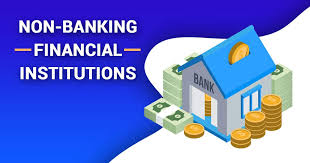Non-Bank Financial Institution
Non-Bank Financial Institution Are Lenders That Are Not Banks and do not have a banking license and not supervised by a national banking regulatory agency.
A non-banking financial institution (NBFI) or non-bank financial company (NBFC) is a financial institution that does not have a full banking license or is not supervised by the Federal Reserve or other international banking regulatory agency. NBFI facilitates bank-related financial services, such as investment, risk pooling, contractual savings, and market brokering. Examples of these include insurance firms, pawnshops, cashier’s check issuers, check cashing locations, payday lending, currency exchanges, and microloan organizations. Alan Greenspan has identified the role of NBFIs in strengthening an economy, as they provide “multiple alternatives to transform an economy’s savings into a capital investment which act as backup facilities should the primary form of intermediation fail.”
Operations of non-bank financial institutions are often still covered under a country’s banking regulations.
Role in the financial system
NBFIs supplement banks by providing the infrastructure to allocate surplus resources to individuals and companies with deficits. Additionally, NBFIs also introduces competition in the provision of financial services. While banks may offer a set of financial services as a packaged deal, Non-Bank Financial Institution unbundles and tailor these services to meet the needs of specific clients. Additionally, individual NBFIs may specialize in one particular sector and develop an informational advantage. Through the process of unbundling, targeting, and specializing, NBFIs enhances competition within the financial services industry.
Non-Bank Financial Institution offers most sorts of banking services, such as loans and credit facilities, private education funding, retirement planning, trading in money markets, underwriting stocks and shares, TFCs(Term Finance Certificate), and other obligations. These institutions also provide wealth management usually partnering with accounting firm such as managing portfolios of stocks and shares, discounting services e.g. discounting of instruments, and advice on merger and acquisition activities. The number of non-banking financial companies has expanded greatly in the last several years as venture capital companies, retail and industrial companies have entered the lending business. Non-bank institutions also frequently support property investments and prepare feasibility, market, or industry studies for companies. However, they are typically not allowed to take deposits from the general public and have to find other means of funding their operations such as issuing debt instruments.
Non-Bank Financial Institution is neither providing the checkbook nor saving account and current account. It only takes a fixed deposit or time deposits.
Growth
Some research suggests a high correlation between financial development and economic growth. Generally, a market-based financial system has better-developed NBFIs than a bank-based system, which is conducive for economic growth. linkages between bankers and brokers.
Stability
A multi-faceted financial system that includes non-bank financial institutions can protect economies from financial shocks and enable speedy recovery when these shocks happen. NBFIs provide “multiple alternatives to transform an economy’s savings into capital investment, [which] serve as backup facilities should the primary form of intermediation fail.”
However, in the absence of effective financial regulations, non-bank financial institutions can exacerbate the fragility of the financial system.
Since not all NBFIs are heavily regulated, the shadow banking system constituted by these institutions could wreak potential instability. In particular, CIVs, hedge funds, and structured investment vehicles, up until the financial crisis of 2007–2008, were entities that focused NBFI supervision on pension funds and insurance companies but were largely overlooked by regulators.
Because this Non-Bank Financial Institution operates without a banking license, in some countries their activities are largely unsupervised, both by government regulators and credit reporting agencies. Thus, a large NBFI market share of total financial assets can easily destabilize the entire financial system. A prime example would be the 1997 Asian financial crisis, where a lack of NBFI regulation fueled a credit bubble and asset overheating. When the asset prices collapsed and loan defaults skyrocketed, the resulting credit crunch led to the 1997 Asian financial crisis that left most of Southeast Asia and Japan with devalued currencies and a rise in private debt.
Due to increased competition, established lenders are often reluctant to include NBFIs into existing credit-information sharing arrangements. Additionally, NBFIs often lack the technological capabilities necessary to participate in information-sharing networks. In general, Non-Bank Financial Institution also contributes less information to credit-reporting agencies than do banks.
For continual growth and sustenance of NBFCs, it is important to have regulation around them while maintaining their innovativeness. An introduction of a regulatory sandbox in a different ecosystem will help them achieve the desired results. Many countries have adopted Regulatory Sandbox and soon more will adopt.
Types of Non-Bank Financial Institution
Risk-pooling institutions
Insurance companies underwrite economic risks associated with illness, death, damage, and other risks of loss. In return for collecting an insurance premium, insurance companies provide a contingent promise of economic protection in the case of loss. There are two main types of insurance companies: general insurance and life insurance. General insurance tends to be short-term, while life insurance is a longer-term contract, which terminates at the death of the insured. Both types of insurance, life, and generally, are available to all sectors of the community.
Although Non-Bank Financial Institution insurance companies do not have banking licenses, in most countries insurance has a separate form of regulation specific to the insurance business and may well be covered by the same financial regulator that also covers banks. There have also been several instances where insurance companies and banks have merged thus creating insurance companies that do have banking licenses.
Contractual savings institutions
Contractual savings institutions (also called institutional investors) allow individuals to invest in collective investment vehicles (CIV) as a fiduciary rather than a principal role. Collective investment vehicles pool resources from individuals and firms into various financial instruments including equity, debt, and derivatives. Note that the individual holds equity in the CIV itself rather than what the CIV invests in specifically. The two most popular examples of contractual savings institutions are pension funds and mutual funds.
The two main types of mutual funds are open-end and closed-end funds. Open-end funds generate new investments by allowing the public to purchase new shares at any time, and shareholders can liquidate their holding by selling the shares back to the open-end fund at the net asset value. Closed-end funds issue a fixed number of shares in an IPO. In this case, the shareholders capitalize on the value of their assets by selling their shares in a stock exchange.
Mutual funds are usually distinguished by the nature of their investments. For example, some funds specialize in high risk, high return investments, while others focus on tax-exempt securities. There are also mutual funds specializing in speculative trading (i.e. hedge funds), a specific sector, or cross-border investments.
Non-Bank Financial Institution Pension funds are mutual funds that limit the investor’s ability to access their investments until a certain date. In return, pension funds are granted large tax breaks to incentivize the working population to set aside a portion of their current income for a later date after they exit the labor force (retirement income).
Market makers
Market makers are broker-dealer institutions that quote a buy and sell price and facilitate transactions for financial assets. Such assets include equities, government and corporate debt, derivatives, and foreign currencies. After receiving an order, the market maker immediately sells from its inventory or purchases to offset the loss in inventory. The differential between the buying and selling quotes, or the bid-offer spread, is how the market-maker makes a profit. A major contribution of the market makers is improving the liquidity of financial assets in the market.
Specialized sectorial financiers
They provide a limited range of financial services to a targeted sector. For example, real estate financiers channel capital to prospective homeowners, leasing companies provide financing for equipment, and payday lending companies that provide short-term loans to individuals that are Underbanked or have limited resources. for example, the Uganda Development Bank
Non-Bank Financial Institution Financial Service Providers
Financial service providers include brokers (both securities and mortgage), management consultants, and financial advisors, and they operate on a fee-for-service basis. Their services include improving informational efficiency for the investors and, in the case of brokers, offering a transactions service by which an investor can liquidate existing assets.
Non-Bank Financial Institution
Welcome to the Gutenberg Editor
The goal of this new editor is to make adding rich content to WordPress simple and enjoyable. This whole post is composed of pieces of content—somewhat similar to LEGO bricks—that you can move around and interact with. Move your cursor around and you’ll notice the different blocks light up with outlines and arrows. Press the
How to Increase Profit Margins Through Virtual CFO Services
How to Increase Profit Margins Through Virtual CFO Services

Great Accounting Firms Share These 10 Traits
Great Accounting Firms Share These 10 Traits which has gone far beyond the paper-pushing days and now involves acting as a virtual CFO

Tax Accountant in Miami Cope with IRS Tax Season Delay
Tax Accountant said IRS delays start of tax season for individual returns would be postponed until February 17 with some as late as March

Miami Accountants Philosophy of Up or Out
Its up or out for Miami Accountants firms are faced with the dilemma of keeping long-term managers that are not ready to be equity partners or let them go.

Contadores en Miami Explican Auditorías del IRS
Contadores en Miami, Gustavo A Viera CPA, explica los pasos de una auditoría, desde la notificación de la auditoría hasta el cierre de la misma
Home » Blog » Accountants in Miami » Non-Bank Financial Institution

